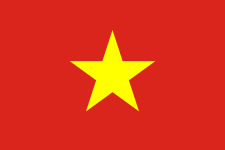When organic becomes an inspiring wellbeing lifestyle
For Tyna Huynh, co-founder of Drinkizz, organic is not just a food choice but a way of life that fosters a deep connection between people, nature and community.




The participation of Zara and H&M in Vietnam fashion market will provide precious lessons to the domestic fashion brands in the long run.

Vietnam has nearly 200 foreign fashion brands which account for 60% of the market, with the most well-known brands come for such mid-range brands as Giordano, Bosini and such high-end brands as CK, Mango, D&G, etc.,... Recently, the impressive appearances of Zara and H&M in the Vietnam market have threatened the casual brands in Vietnam which were once very famous like NinoMax, BlueExchange, PT2000 and Canifa.
The question concerning the biggest weakness of Vietnam fashion industry has been raised.
TheLEADER had a talk with the former chairman of the Vietnam National Textiles and Garment Group Vietnam Le Quoc An on this issue.
What do you think about the blooming of Big foreign fashion brands like Zara and H&M in Vietnam fashion market?
Le Quoc An: For the passing years, globally pre-eminent management thinkers Chan Kim and Renée Mauborgne’s Blue Ocean Strategy, which is providing customers with higher quality products and services at a more competitive price than other rivals in the market, has been applied successfully by giant foreign fashion brands like Zara, H&M and ASOS.
These brands that have the highest development level in the world have identified the young and low-income people as their main customers, which has helped attract consumers all over the world.
With the opening of Zara last year and H&M’s this year, the fashion market in Vietnam has become more bustling, stimulating consumer demand and also leaving precious lessons for Vietnamese manufacturers for the long term.
Do you think that the massively opening of these brands will threaten Vietnamese fashion companies?
Le Quoc An: In the short term, this mainstream may have certain influences on Vietnamese brands having the same identified customers like Ninomax, Blue, Foci and PT2000. However, if Vietnamese brands have suitable business strategies like re-identifying their target market and better controlling the prices, they can still compete and remain their position in the market.
Such brands having different target market as An Phuoc, Viet Tien, Nha Be and May 10 will not be significantly impacted.
The failure of some Vietnamese fashion companies is because of their own internal power management. Market mechanism acts as a living organism, with old units dying, other new units being born and developing.
What is the biggest weakness of Vietnamese fashion industry? And what do Vietnamese fashion companies should do in the context of the integration wave in the at-home playground?
Le Quoc An: Opposite to the giant foreign brands, Vietnamese brands’ strength is well controlling the manufacturing stage; however, they are still weak at development research, design and value chain management. Therefore, in order to be able to compete and develop, we have to alleviate those obstacles, especially reevaluate the own internal power and focusing on a certain and suitable business strategy.
Vietnam has a potential consumer market with the total population of over 90 million and the annual increase in the purchasing power of 10 per cent at average. Each company should identify their own target market without following any tendency.
Thank you very much!
For Tyna Huynh, co-founder of Drinkizz, organic is not just a food choice but a way of life that fosters a deep connection between people, nature and community.
Embracing respectful workplaces could very well be the key to unlocking a more prosperous future for Vietnam's garment industry.
Vietnamese businesses have had a long journey with great achievements, and this path will continue and blossom in years to come.
While some jobs are expected to be replaced by emerging AI applications, the technology is broadly seen as a catalyst for positive transformation in the workforce.
The energy transition is bringing forth new challenges, particularly in refining financial systems.
Alex Hambly talks about investment opportunities in Vietnam following his appointment as chief investment officer (CIO) of VinaCapital.